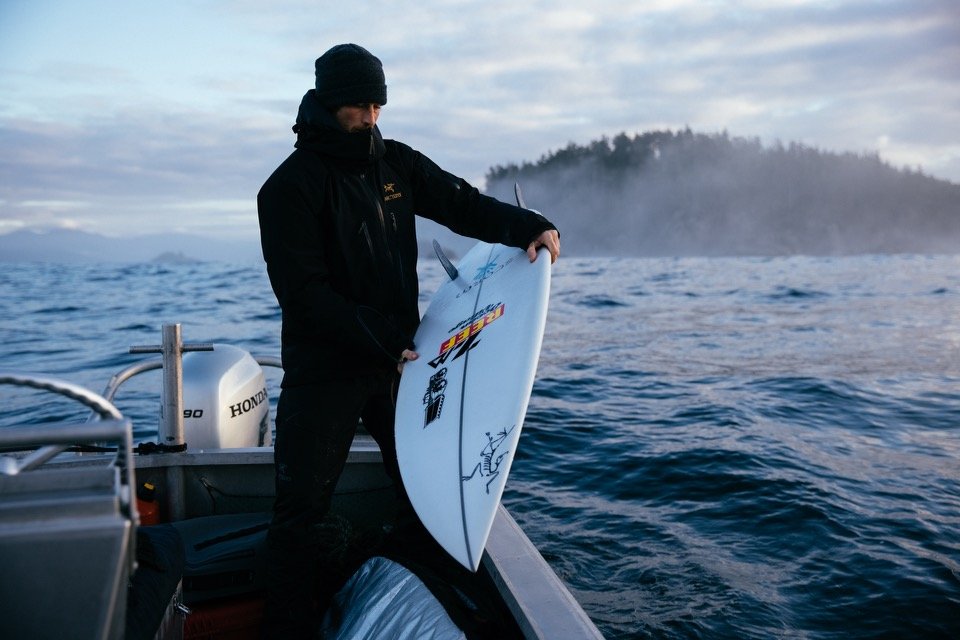Something Bigger than Just My Wave: Environmental Activism and the Surf Movie
Photo of Pete Devries taken by Jeremy Koreski
“…the surf movie can never be fully detached from history, just as even the most endless of summers can only tell its full story when framed by the other seasons.”
John Engle, Surfing in the Movies: A Critical History, 2015, 3.
Surf movies have come a long way since Bud Browne’s Hawaiian clips of the 1950s.
But in a way, they’ve remained the same: Representations of beauty, power, and the human form locking into good waves. And of societal values germane to surfing communities in particular historical contexts.
Browne, then later, John Severson, Bruce Brown, and Greg Noll are credited with inventing the genre. As Matt Warshaw writes, the design was simple: “two or three dozen surf-action montages interrupted periodically by a comedy sketch or an on the-road-vignette” (2003, 582). John Engle describes the format as “spectaculars of action, comedy, and live narration” (2015, 50). While the action shots of toned bodies riding beautiful waves have been a constant through the decades, the comedy – such that it was – has fallen away. As the genre has matured, surf movies have become more technically and artistically worthy (Engle 2015, 28). Their messaging has become more deliberate.
The surf movie is more than a format. It’s a message.
The makers of early surf movies were based primarily in southern California, which was the epicenter of the exploding surf industry. It’s not surprising that these movies had an American sensibility. They represented an exuberance of the Post-War Era. Within a few years, expressions of simple joy would morph subtly into dreamy escapism from, perhaps, the existential threat of the Korean and Vietnam drafts. The message would shift again with the decadence of the 1980s and the ever-growing commercialization of the sport into the 1990s. The high-energy, action-packed surf videos and shortboard pornos were the perfect expression of this particular Geist.
But note the shift from Taylor Steele’s Momentum (1992), all of its hypermasculine thrusting, to his Castles in the Sky (2010), a thoughtful piece that celebrates in equal parts high performance surfing, the natural environment, and our shared humanity.
While still focused on the beauty and power of the surf and on the grace and athleticism of deft surfers, surf movies of the 2000s are more sophisticated, even political. This is especially true with respect to the environment.
At first, the environmental messaging was indirect. Both Singlefin: Yellow (2003), by Jason Baffa, and One California Day (2007), by Baffa and Mark Jeremias, contain brief but poignant shots of the fuming stacks of shoreline power plants. Iconic surf spots are juxtaposed with reminders of the oil patch at Huntington Beach and the nuclear energy plant at San Onofre. The latter film opens with a sequence of California traffic jams, which then cuts to Skip Frye dutifully picking up beach garbage as he shares with viewers his appreciation of the environment. As various dimensions of the global environmental catastrophe have intensified over this millennium, surf films have become more explicit in their calls for action.
Featuring Tofino’s own Pete Devries and Jeremy Koreski, in partnership with Raincoast Conservation Foundation, Groundswell (2012) is a prime example of a film blending stunning surf shots, spectacular scenery, and a clear stance for the environment. The film, by Chris Malloy, also represents solidarity with the Heiltsuk First Nation against the oil industry, articulating a message of protest against the proposed Northern Gateway tar sands oil pipeline, which would have cut through the Great Bear Rainforest and brought giant oil tankers to navigate the narrow waterways to and from the Port of Kitimat, BC. Similarly, Angie Davis’ 2016 film, Double Barrel, takes on the global oil industry. Davis does not hold back in her cinematic critique of the colonialism of big oil and of the oil industry wreaking havoc on the coastal village of Lobitos in northern Peru. Shots of gorgeous waves are interspersed with images of dilapidated oil rigs and platforms.
Other recent surf films have taken on plastics pollution. Gerry Lopez in The More Things Change (2017), by Nathan Myers, uses his voice to bring attention to the environmental harms of plastic and of surf tourism in Bali. He uses his platform to raise awareness of and support for Project Clean Uluwatu, which is working to restore the area’s pristine nature. The very recent Of the Sea, by Jordyn Romerp, Leah de Leon, and Steven Talens, highlights the story of Katherine Terrell, mother, surfer, and environmental activist. Terrell and her parents left Vietnam after the war and sought refuge in the US, where they settled in California. As an activist, she worked with grassroots organizations to ban single-use plastic bags in California, for which she received Surfrider Foundation’s Wavemaker of the Year Award in 2011. Terrell is now based in Costa Rica where she runs her Jeux De Vagues sustainable swimwear, made from recycled water bottles and fishing net.
Surf filmmakers of the 21st century have not shied away from critically examining the surf industry. In 2011, the relatively hard-hitting Manufactured Stoke was released, shining a searing light on the environmental harms caused by the mass production of surfboards. The film by Pierce Michael Kavanagh and Geoffrey Smart focuses on the 2005 closure of Clark Foam, which had a worldwide monopoly on the production of polyurethane-foam surfboard blanks. As William Finnegan writes, a blank is the “lightweight alabaster core without which there would be no modern surfboard” (2006, 36). According to Finnegan, Gordon Clark’s seven-page fax announcing his abrupt decision “alluded to run-ins with government regulators, primarily over the chemicals and equipment he used, and to claims filed against him by ex-employees or their survivors” (2006, 37). But the closure of Clark Foam spurred much-needed innovation in surfboard construction, opening doors to the use of recycled and plant-based materials. In 2019, Stab Magazine ran a short video featuring Mick Fanning riding several boards that met Sustainable Surf’s ECOBOARD standards. Its title was “If You’re Not On Tour, You Should Definitely Be Riding A Sustainable Surfboard.”
This year, The Big Sea may stir a similar innovation within the industry. With its title playing on the real big “c” word, the film explores the toxic nature of Neoprene production and by extension the link between cold-water surfing, wetsuits, and “Cancer Alley,” the site of the highest rate of cancer caused by air pollution in the US. In 2015, the US Environmental Protection Agency acknowledged that the extraordinarily high cancer risk in Reserve, Louisiana – a predominantly African American community – is due to chloroprene emissions from the nearby Denka plant. Synthetic chloroprene rubber is Neoprene, and the vast majority of Neoprene wetsuits trace their origins to either the Denka plant in Louisiana or in Japan. In late-February of this year, the US Justice Department launched a lawsuit against Denka and DuPont for violating the Clean Air Act and presenting “an imminent and substantial endangerment to public health and welfare” (Guardian 2023). The Big Sea may very well be the catalyst for a shift toward wetsuits made from natural rubber.
In many ways, the surf movie is the perfect vehicle for delivering social, political, and environmental messages. The format of mesmerizing waves and beautiful surfing has a profound impact. Some might say that it opens the soul to a more expansive reality. Importantly, it bears the potential of moving us toward addressing the existential threats we are all facing.
As Lilly Woodbury of Surfrider Canada puts it:
“Film is one of the most powerful vehicles for influencing change. Film continues to be a compelling voice for people, for flora and fauna, for all ecosystems. Through film, awareness about social and environmental issues can ripple around the planet and inspire people to take action.”
After a two-year hiatus, the Surfrider Pacific Rim Short Film Festival is back. Launched in 2016, the film fest showcases local, national, and international shorts highlighting diverse efforts to celebrate and protect the ocean, waves, and beaches. The festival focuses on the work toward healthy oceans, the interface of the ocean and land, and the need for environmental activism. The film fest advances Surfrider’s mission of protecting and enjoying the world’s oceans and waterways through a powerful activist network. This year, the film fest is highlighting new shifts in surf movies reflecting a larger societal commitment to toward greater diversity, inclusion, and Indigeneity. We hope you’ll join us on 14 and 15 April at the General Store in Tofino or on-line at https://www.pacificrim.surfrider.org/film-fest-home.
The last word goes to Mr. Pipeline Lopez: “If you get everybody just to do a little bit then it adds up to something, so you try and make people think about the bigger picture rather than just my wave. Hopefully some good comes” (in The More Things Change, 2017).
Genevieve Fuji Johnson writes for Surfrider Pacific Rim. With thanks to Adam Tory and Alan Potter.
Sources
John Engle, Surfing in the Movies: A Critical History (McFarland & Company, 2015).
William Finnegan, “Blank Monday: Could Grubby Clark destroy surfing?” The New Yorker (21 August 2006).
Alexa Honenberg, “Of the Sea – A female-driven surf film with an environmental message,” Still Stoked: Daring Dream, Wild Paths (https://www.stillstoked.com/watch-me/of-the-sea-female-surf-film-environment/)
Oliver Laughland, “US Justice Department Sues Two Companies over Pollution in Louisian’s ‘Cancer Alley’,” The Guardian (https://www.theguardian.com/us-news/series/cancer-town/2023/feb/28/all)
Raincoast Conservation Foundation, “Groundswell: A small film about making a big stand,” (https://www.raincoast.org/groundswell/)
Stab, “If You’re Not On Tour, You Should Definitely Be Riding A Sustainable Surfboard,” Stab Magazine 25 June 2019 (https://stabmag.com/hardware/if-youre-not-on-tour-you-should-definitely-be-riding-a-sustainable-surfboard/).
Matt Warshaw, The Encyclopedia of Surfing (Harcourt, 2003).

